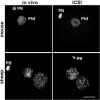The effect of interspecific oocytes on demethylation of sperm DNA
- PMID: 15136736
- PMCID: PMC419658
- DOI: 10.1073/pnas.0400730101
The effect of interspecific oocytes on demethylation of sperm DNA
Abstract
In contrast to mice, in sheep no genome-wide demethylation of the paternal genome occurs within the first postfertilization cell cycle. This difference could be due either to an absence of a sheep demethylase activity that is present in mouse ooplasm or to an increased protection of methylated cytosine residues in sheep sperm. Here, we use interspecies intracytoplasmic sperm injection to demonstrate that sheep sperm DNA can be demethylated in mouse oocytes. Surprisingly, mouse sperm can also be demethylated to a limited extent in sheep oocytes. Our results suggest that the murine demethylation process is facilitated either by a sperm-derived factor or by male pronuclear chromatin composition.
Figures



References
-
- Jaenisch, R. & Bird, A. (2003) Nat. Genet. 33, 245-254. - PubMed
-
- Bestor, T. H. (2003) Ann. N.Y. Acad. Sci. 983, 22-27. - PubMed
-
- Robertson, K. D. (2002) Oncogene 21, 5361-5379. - PubMed
-
- Reik, W., Santos, F. & Dean, W. (2003) Theriogenology 59, 21-32. - PubMed
-
- Li, E. (2002) Nat. Rev. Genet. 3, 662-673. - PubMed
Publication types
MeSH terms
Substances
LinkOut - more resources
Full Text Sources

